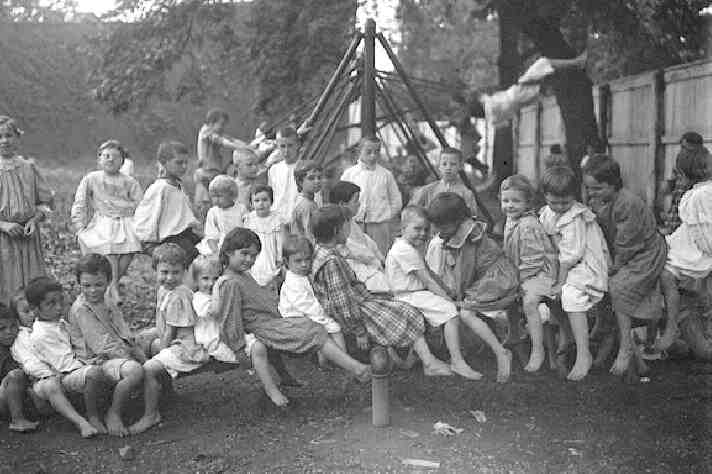
Smocks in the United States: Gender

Figure 1.--This American playground image is undated, but we would guess about 1910. Some of the children, including a few boys seem to be wearing smocks. It certainly was taken during the summer. I'm not sure if it was associated with a school or Sunday school.
|
|
A smock is mostly seen today as a girl's garment in America. This was not always the case. We see both boys and girls wearing them in the late 19th century, although here there were social-class differences. These conventions concern the smovcks worn at home, as smocks were not a common school garment in America, lthough they might have been worn at a few nursery chools. It is difficult to make definitive assesments at this time beause our information is still quite limited. Many of the children we see wearing smocks are children from affluent families. After the turn of the 20th century we see fewer boys wearing smocks, but there are still some in the early 20th century. Most boys wearing smocks after the turn of the 20th century look to be pre-school boys. After World War I (1914-18) we see very few American boys wearing smocks, especially after the 1920s.
Reader Comment
A French reader was struck by the barefoot children children not wearing shoes. He writes, "It seems a bit stange to see all these beautifull children with bare feet. America as such a rich county with so much industry; has the duty to take care of its children.
Here , since 1900 , if a child came in the school with
delapidated shoes or garment, the social service provided shoes and clothing, especially after World War I and II. We thought if these children didn't have shoes, perhaps they were not being fed right either. At the same time we had very rich people, with scandalous behaviour. A humane country has no right to accept that." Our French reader reflects the association in Europe of barefeet and poverty. It was very common for children to go barefoot, especilly in the South and during the Summer. Both boys and girls went barefoot, perghaps somewhat more common for the boys. There was an element of the European attitude in America. The children of really rich children did not go barefoot. Many children, especially before World Wr I is in America did gobarefoot, even to school. There was no stiigmna of poverty. Many children wanted to go barefoot, finding it more comfortable than shoes which often did mnot fit as well as shoes today. The invention of inexpensive canvas shoes with rubber soles was probably a factor in the general decline of the practice of going barefoot. Readers may want to consult the HBC barefoot pages for America and France to read about the differing attitudes.
Charles .
HBC

Navigate the Boys' Historical Clothing Smock-related pages:
[Return to the Main U.S. early 20th centurt smock page]
[Return to the Main U.S. smock page]
[Pinafores]
[Fauntleroy suits]
[Fauntleroy dresses]
[Sailor hats]
[Park outings]
[French page]
[Renoir page]
[Smocks]
[School smocks]
[Barefeet]
Navigate the Boys' Historical Clothing Web Site:
[Introduction]
[Activities]
[Biographies]
[Chronology]
[Clothing styles]
[Countries]
[Bibliographies]
[Contributions]
[FAQs]
[Glossary]
[Satellite sites]
[Tools]
[Boys' Clothing Home]
Created: December 29, 2003
Last updated: December 30, 2003



